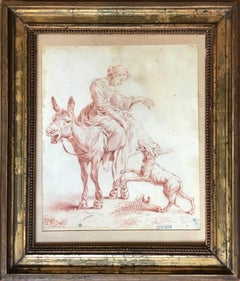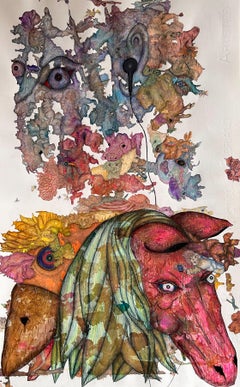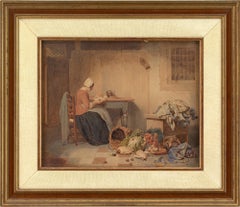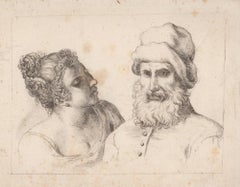Dutch School Figurative Drawings and Watercolors
to
1
2
Overall Width
to
Overall Height
to
1
1
1
4,863
3,138
588
383
320
254
208
201
166
152
54
53
49
48
2
2
2
2
1
1
1
1
1
1
1
1
2
Style: Dutch School
Sanguine drawing "Shepherdess on a Donkey" by Nicolaes Berchem
By Nicolaes Berchem
Located in New York, NY
Provenance: Mercedes von Dietrichtein, Buenos Aires. Alexander von Dietrichstein. By descendants Morritz von Diestrichstein.
Nicolaes Pieterszoon Berchem (1 October 1620 – 18 February 1683) was a highly esteemed and prolific Dutch Golden Age painter of pastoral landscapes, populated with mythological or biblical figures, but also of a number of allegories and genre pieces.
He was a member of the second generation of "Dutch Italianate landscape" painters. These were artists who travelled to Italy, or aspired to, in order to soak up the romanticism of the country, bringing home sketchbooks full of drawings of classical ruins and pastoral imagery. His paintings, of which he produced an immense number, (Hofstede de Groot claimed around 850, although many are misattributed), were in great demand, as were his 80 etchings and 500 drawings. His landscapes, painted in the Italian style of idealized rural scenes, with hills, mountains, cliffs and trees in a golden dawn...
Category
17th Century Dutch School Figurative Drawings and Watercolors
Materials
Paper, Chalk
Thoughtful woman
Located in PARIS, FR
Karl HUBBUCH (1891-1979)
Thoughtful young woman, circa 1920-30
Pen and ink, pink colored pencil on paper
Stamp of the Karl Hubbuch estate in the upper left corner
14,5 x 14 inch
German artist and figure of the New Objectivity, Karl Hubbuch was born in Karlsruhe in 1891. He received his first artistic training at the Academy of Fine Arts in 1908, where he became friends with Georg Scholz and Rudolf...
Category
1920s Dutch School Figurative Drawings and Watercolors
Materials
India Ink, Pencil, Color Pencil
Related Items
Contemporary Drawing With Colored Pencils And Ink On Fabriano Paper. "Visions"
Located in Bogotá, Bogotá
Contemporary drawing work that combines the use of colored pencils and ink on a layer made with natural dyes from leaves and flowers. It is a surreal and fantastic drawing that seeks...
Category
2010s Dutch School Figurative Drawings and Watercolors
Materials
Paper, Ink, Color Pencil
Contemporary Drawing "Blue Prayer" Draw, Pastel, Ink And Colored Pencils
Located in Bogotá, Bogotá
Drawing, pastel, Pencil, Petal Flowers, Color and Ink on Paper.
The base of this drawing is ordinary yellow paper of 80 gr. I use natural dyes from flowers, herbs, leaves, and tree ...
Category
2010s Dutch School Figurative Drawings and Watercolors
Materials
Paper, Pastel, Ink, Pencil, Color Pencil
Drawing, pastel, ink and colored pencils. "Free spirits"
Located in Bogotá, Bogotá
Pastel, Pencil, petal flowers, Color and Ink on Paper.
The base of this drawing is Fabriano paper of 120g /m2. I use natural dyes of flowers, herbs, leaves, bark of trees as the fir...
Category
2010s Dutch School Figurative Drawings and Watercolors
Materials
Paper, Pastel, Ink, Pencil, Color Pencil
Italian neoclassical 19th century Italian figurative drawing antique frieze on paper
Located in Florence, IT
This drawing (pencil, ink and white lead on brown paper, 23 x 19, 5 cm) extremely accurately depicts an image taken from or inspired by antiquity, specifically an acanthus girale in ...
Category
19th Century Dutch School Figurative Drawings and Watercolors
Materials
Paper, Ink, Pencil, Chalk
The Great Escape by Patsy McArthur - unique charcoal on paper - white box frame
Located in Dallas, TX
This is a beautiful and unique charcoal on paper drawing. The Fabriano paper is a high quality watercolour grade set in a custom white wood frame, all archival materials.
Scottish ...
Category
2010s Dutch School Figurative Drawings and Watercolors
Materials
Conté, Charcoal, Archival Paper
H 32.29 in W 50.4 in D 1.58 in
Nur Jahan seated with a painted spice jar. Rajasthani School, 19th cent.
Located in Middletown, NY
Ink and gouache with gold heightening on fibrous, brown laid paper with a Jaipur Court Fee tax stamp in purple ink, 13 3/8 x 8 3/4 inches (340 x 222 mm). Toning, handling creases and...
Category
19th Century Dutch School Figurative Drawings and Watercolors
Materials
Gold
Shah Jahan taking tea with a concubine. Rajasthani School, 19th century
Located in Middletown, NY
Ink and gouache with gold heightening on brown laid paper with a Jaipur Court Fee tax stamp in black ink, 13 3/8 x 8 3/4 inches (340 x 222 mm). Toning, handling creases and minor sca...
Category
19th Century Dutch School Figurative Drawings and Watercolors
Materials
Gold
Three hunters; two with a spear and dagger... Rajasthani School, 19th century
Located in Middletown, NY
Ink and gouache with gold heightening on brown laid paper with a Jaipur Court Fee tax stamp in black ink, 12 5/8 x 8 9/16 inches (320 x 217 mm). Toning, handling creases and minor sc...
Category
19th Century Dutch School Figurative Drawings and Watercolors
Materials
Gold
Shah Jahan in a shirt of mail and plate of armor. Rajasthani School, 19th cent.
Located in Middletown, NY
Ink and gouache with gold heightening on fibrous, brown laid paper with a Jaipur Court Fee tax stamp in black ink, 13 3/8 x 8 3/4 inches (340 x 222 mm). Toning, handling creases and ...
Category
19th Century Dutch School Figurative Drawings and Watercolors
Materials
Gold
"Evocation" Drawing, Ink and Colored Pencils
Located in Bogotá, Bogotá
Pencil, Petal Flowers, Color and Ink on Paper. The base of this drawing is 120g/m2 Fabriano paper. I use natural dyes from flowers, herbs, leaves, and tree bark as the first drawing ...
Category
2010s Dutch School Figurative Drawings and Watercolors
Materials
Paper, Ink, Pencil, Color Pencil
Tippie Comic Strip Original Art - Female Cartoonist
Located in Miami, FL
An early example from pioneering Female Cartoonist/ Illustrator Edwina Dumm, who draws a comic strip from her long-running cartoon series Tippie which lasted for almost five decades. Signed and dated Edwina, 9-25, matted but unframed.
Frances Edwina Dumm (1893 – April 28, 1990) was a writer-artist who drew the comic strip Cap Stubbs and Tippie for nearly five decades; she is also notable as America's first full-time female editorial cartoonist. She used her middle name for the signature on her comic strip, signed simply Edwina.
Biography
One of the earliest female syndicated cartoonists, Dumm was born in Upper Sandusky, Ohio, and lived in Marion and Washington Courthouse, Ohio throughout her youth before the family settled down in Columbus.[1] Her mother was Anna Gilmore Dennis, and her father, Frank Edwin Dumm, was an actor-playwright turned newspaperman. Dumm's paternal grandfather, Robert D. Dumm, owned a newspaper in Upper Sandusky which Frank Dumm later inherited. Her brother, Robert Dennis Dumm, was a reporter for the Columbus Dispatch, and art editor for Cole Publishing Company's Farm & Fireside magazine.
In 1911, she graduated from Central High School in Columbus, Ohio, and then took the Cleveland-based Landon School of Illustration and Cartooning correspondence course. Her name was later featured in Landon's advertisements. While enrolled in the correspondence course, she also took a business course and worked as a stenographer at the Columbus Board of Education.
In 1915, Dumm was hired by the short-lived Republican newspaper, the Columbus Monitor, to be a full-time cartoonist.[2] Her first cartoon was published on August 7, 1915, in the debut issue of the paper. During her years at the Monitor she provided a variety of features including a comic strip called The Meanderings of Minnie about a young tomboy girl and her dog, Lillie Jane, and a full-page editorial cartoon feature, Spot-Light Sketches[3]. She drew editorial cartoons for the Monitor from its first edition (August 7, 1915) until the paper folded (July 1917). In the Monitor, her Spot-Light Sketches was a full-page feature of editorial cartoons, and some of these promoted women's issues. Elisabeth Israels Perry, in the introduction to Alice Sheppard's Cartooning for Suffrage (1994), wrote that artists such as Blanche Ames Ames, Lou Rogers and Edwina Dumm produced:
...a visual rhetoric that helped create a climate more favorable to change in America's gender relations... By the close of the suffrage campaign, women's art reflected the new values of feminism, broadened its targets, and attempted to restate the significance of the movement.[4]
After the Monitor folded, Dumm moved to New York City, where she continued her art studies at the Art Students League. She was hired by the George Matthew Adams Service[5] to create Cap Stubbs and Tippie, a family strip following the lives of a boy Cap, his dog Tippie, their family, and neighbors. Cap's grandmother, Sara Bailey, is prominently featured, and may have been based on Dumm's own grandmother, Sarah Jane Henderson, who lived with their family. The strip was strongly influenced by Mark Twain’s Adventures of Huckleberry Finn, as well as Dumm’s favorite comic, Buster Brown by Richard F. Outcault. Dumm worked very fast; according to comics historian Martin Sheridan, she could pencil a daily strip in an hour.[6]
Her love of dogs is evident in her strips as well as her illustrations for books and magazines, such as Sinbad, her weekly dog page which ran in both Life and the London Tatler. She illustrated Alexander Woollcott's Two Gentlemen and a Lady. For Sonnets from the Pekinese and Other Doggerel (Macmillan, 1936) by Burges Johnson (1877–1963), she illustrated "Losted" and other poems.
From the 1931 through the 1960s, she drew another dog for the newspaper feature Alec the Great, in which she illustrated verses written by her brother, Robert Dennis Dumm. Their collaboration was published as a book in 1946. In the late 1940s, she drew the covers for sheet music by her friend and neighbor, Helen Thomas, who did both music and lyrics. During the 1940s, she also contributed Tippie features to various comic books including All-American Comics and Dell Comics.
In 1950, Dumm, Hilda Terry, and Barbara Shermund...
Category
1920s Dutch School Figurative Drawings and Watercolors
Materials
Ink, Color Pencil, Graphite
A dazzling Venetian Regatta Boat Study attributed to Alessandra Mauro
Located in PARIS, FR
This stunning Baroque study depicts a regatta boat, a type of vessel developed in eighteenth-century Venice for the regattas organized by the Serenissima during visits by royalty and princes. We propose to link this drawing to the work of Alessandro Mauro, an artist who specialized in this type of composition, as illustrated by a drawing from him at the Metropolitan Museum.
1. Description of the boat
The greatest decorative fantasy reigns in this preparatory study, which blends mythological and exotic elements with references to ancient Egypt. Our drawing is probably an initial thought, destined to be refined and clarified later in pen and ink (as evidenced by the ink stain in the lower right). A quadriga of seahorses guided by Neptune stands at the stern of the boat, shown well above the waterline (perhaps to outline its empty volume). One of the seahorses is ridden by a newt, while Amphitrite lies at the feet of the sea god.
The center of the boat is occupied by a vast baldachin resting on four atlantes and surmounted by a figure riding an animal (a dragon?). Three figures sit beneath the canopy, one of them on a griffin-shaped seat. This allusion to Egyptian antiquity echoes the winged sun (sometimes a symbol of the god Horus, as in the temple of Edfu in Egypt) that adorns the sides of the promontory on which this baldachin rests.
Another flag-bearer figure crouches at the stern of the boat on a raised seat, on the reverse of which is a crowned mermaid whose arm, extended backwards, rests on a mascaron decorated with a radiant face (Helios?) and whose torso surmounts an elephant's head. The heads of the rowers and their oars are sketched all along the boat, whose sides are embellished with elongated naiads.
2. The Venetian regatta boats
An exhibition held in 2013 at the Ca' Rezzonico (the Venetian eighteenth-century museum) paid tribute to these regatta boats through studies and prints depicting them. The regattas organized by the Serenissima in honor of visiting princes and sovereigns were among the most spectacular ceremonies in Venice. Some important artists of the 18th century contributed to the creation of these extravagant boats which were given exotic names such as bissona, malgarota or peota.
The specialists in this field were Andrea Urbani and the brothers Alessandro and Romualdo Mauro. They were born into a family of theater decorators in Piedmont, but little is known about their detailed biography. Alessandro was the architect of the Dresden opera house and of the St. Samuel Theater in Venice (in collaboration with his brother Romualdo), but also worked as stagehand and set designer in Vienna, Rome and Turin. A drawing produced around 1737 from the Metropolitan Museum (7th photo in the gallery) bears witness to his activity as a regatta boat designer.
This drawing is a much more elaborate version than the one presented here, having been entirely reworked in brown ink. However, a figure at the bow of the boat, executed solely in black chalk, still bears witness to a technique similar to that of our drawing.
It is difficult to know whether the boat depicted in our drawing was a project for an actual boat or whether it remained in the planning stage, but the front of our boat (Neptune and the quadriga of seahorses ridden by a newt) bears several similarities to that of a parade boat depicted in the print published by Michele Marieschi entitled Regatta on the Grand Canal, between the Foscari and Balbi Palaces (last photo in the gallery). This print is dated 1741, which could confirm that our work dates from around 1740.
The area between Neptune and the quadriga that precedes him on this strange paddle-boat appears to be partially submerged, confirming that the waterline of our boat was probably intended to be much lower than the one shown in our drawing.
The Correr Museum’s collection holds one of the most important collection of engravings and drawings devoted to these specifically Venetian Baroque productions. These boats were intended to last the duration of a festival. Today, they are only documented by preparatory drawings or prints that testify to the sumptuousness of their decoration. This taste for regatta boats lasted throughout the Venetian eighteenth century, and the conception of regatta boats also attracted great masters such as Giambattista Tiepolo, Francesco Guardi or Giambattista Piranesi...
Category
Mid-18th Century Dutch School Figurative Drawings and Watercolors
Materials
Chalk
H 15.75 in W 19.25 in
Previously Available Items
Johannes Engel Masurel, The Kitchen Princess, Antique Watercolour
Located in Cheltenham, GB
This mid-19th-century watercolour by Dutch artist Johannes Engel Masurel (1826-1915) depicts a young lady reading in a kitchen interior littered with vegetables.
Transfixed by the contents of a novel, she’s oblivious to the cluttered environment. A smorgasbord of fresh goods sprawled on cold checkerboard tiles...
Category
1850s Dutch School Figurative Drawings and Watercolors
Materials
Paper, Watercolor
Maiden with a bearded man in a commoners wool high cap
Located in Middletown, NY
Pencil on hand made cream laid paper, 8 1/4 x 10 3/8 inches (210 x 264 mm), wide but unevenly trimmed margins. Scattered light foxing and areas of light yellow discoloration scatter...
Category
18th Century Dutch School Figurative Drawings and Watercolors
Materials
Handmade Paper, Laid Paper, Pencil
Etude précoce. Mixed media. Signed and dated (19)47.
Located in Paris, FR
Etude précoce. Mixed media. Signed and dated (19)47.
Corneille was born in Liege, Belgium, although his parents were Dutch and moved back to the Netherlands when he was 12. He studi...
Category
1940s Dutch School Figurative Drawings and Watercolors
Materials
Mixed Media
Landscape Drawing, Old Master, 17th Century, by Van Nikkelen, Dutch Golden Age
Located in Greven, DE
Landscape with tree and water-bearing farmer
Black chalk on paper
Sheet 30.2 x 24 cm
Plain gold moulding, 48 x 41.3 cm
Van Nickelen was a successful artist in the 17th century Netherlands...
Category
17th Century Dutch School Figurative Drawings and Watercolors
Materials
Paper, Chalk
Dutch School figurative drawings and watercolors for sale on 1stDibs.
Find a wide variety of authentic Dutch School figurative drawings and watercolors available for sale on 1stDibs. Works in this style were very popular during the 20th Century, but contemporary artists have continued to produce works inspired by this movement. Many Pop art paintings were created by popular artists on 1stDibs, including and Nicolaes Berchem. Frequently made by artists working with Paper, and Chalk and other materials, all of these pieces for sale are unique and have attracted attention over the years. Not every interior allows for large Dutch School figurative drawings and watercolors, so small editions measuring 7.49 inches across are also available. Prices for figurative drawings and watercolors made by famous or emerging artists can differ depending on medium, time period and other attributes. On 1stDibs, the price for these items starts at $767 and tops out at $9,500, while the average work sells for $2,114.



